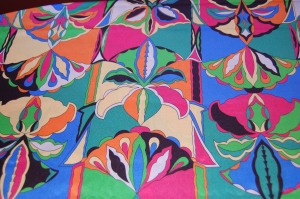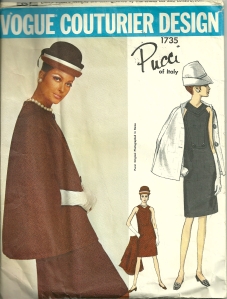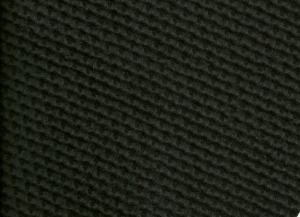In the world of designer fashion, there are certain names which are synonymous with specific looks. Obvious examples are Coco Chanel with her little black dress and classic cardigan jacket, Christian Dior with his figure-enhancing full skirts and feminine décolleté necklines, and Emilio Pucci with his distinctive colorful prints, smart sportswear and flowing at-home-wear.
Lately I’ve been thinking about Emilio Pucci (1914-1992) a lot. It all started a couple of years ago on one of my West Coast visits to Britex Fabrics in San Francisco. I had already decided upon several lengths of fabric, when I saw a silk charmeuse, which clearly spoke to me of Pucci. The design was so amazing, the colors so vibrant, and the silk so luscious, that, with a little encouragement from my husband, I added it to my pile. At 60” wide, I thought 2 yards would suffice for a blouse, not really knowing what I would make.
The silk I purchased seemed to have all the bells and whistles of a classic Pucci print. (Pucci’s daughter, Laudomia took over the business after her father’s death, and has continued her father’s signature style.) He only used the finest, luscious fabrics with a color palette “straight from the Aegean horizon” according to the entry on him in The St. James Fashion Encyclopedia ( Visible Ink Press, Detroit, MI, 1997, pages 325-326): “turquoise and ultramarine set against sea green and lime, or hot fuchsia and sunflower yellow”. These colors are arranged in “optical fantasies of geometric shapes” which eschew repetitiveness. And, finally, every authentic Pucci fabric carries his discreet “Emilio” signature. (The Vintage Traveler blog has an excellent post on Pucci and his sporty prints, which shows another example of his signature and his diverse designs.)
Shortly after this fabric purchase, I began to get a greater and new appreciation for Pucci’s diversity as a fashion designer as I acquired a few of his Vogue Designer patterns. Instead of featuring styles dependent upon his bright and unusual fabric designs, they showed feminine dresses and jackets, with clean lines and a surprising touch of demureness. Here are the three patterns I purchased:
Some other of his designs for Vogue patterns were featured in Vogue Pattern Book Magazine:

The caption in this June/July 1972 article says: “Emilio Pucci adds glamour to your life with an off-white silk crepe pantsuit…” while the lower picture shows his “signature colors on a silk jersey lounge gown.”
Both the fabric and the patterns sat in hibernation in one of the closets in my sewing room until an idea began to take hold in my mind. I decided I’d like to use one of my Pucci patterns for my authentic Pucci fabric. It just seemed totally logical to me. I measured my fabric again and found I had closer to 2¼ yards. I was envisioning pattern # 1418, with the dress in the silk print, paired with the jacket in black, lined in the same silk. With this plan in mind, I found a lightweight, soft and silky wool/cotton waffle weave in black at Britex Fabrics in early February while I was on the West Coast for Susan Khalje’s Couture Sewing School Class – perfect for the jacket.
With pattern, fabrics, and a vision, I was ready to go on my next big project. There was only one gnawing question – would I have enough yardage of the Pucci silk to make that sheath-style dress and line the jacket?
The answer to that question – deserves its own Fifty Dresses post!











This will be a gorgeous ensemble.
Thank you, Mary!
Love, love, love that print. A bit of Pucci brightens up the day!
I’m really curious about your next post, hope it all worked out!
I agree that a Pucci print definitely brightens up the day – and makes good transition sewing from Winter into Spring!
Oh, WOW, what a classic Pucci print! I do hope you had enough for the lining. And thanks for the mention and the link.
Oh, you’re welcome, Lizzie! Pucci had a fascinating career which is worth reading about.
Waiting with bated breath!! You shouldn’t leave us hanging!!! Packed up and off for a week of sewing with Susan khalje. Wish you were going to be there,
I am so, so envious!! What are you starting with Susan this time? Something gorgeous, I’m sure!
Of course, there was not enough fabric, but you figured out a way. I eagerly await the next post, as I cannot imagine what you did!
Whoever thought there could be such mystery and intrigue with fashion sewing? Stay tuned …
Congratulations on recognizing that great Pucci silk print!
Please forgive me for offering some unsolicited advice: (speaking as a retired design teacher) I’d encourage you to think hard about a way to relate the matte black jacket to the silk dress, if you are planning to wear them as an outfit. (Sadly, the lining won’t show when the jacket is buttoned, so the dress and jacket won’t look obviously “made for each other,” even though they are!) That’s a very strong value & fabric contrast, and may appear to “cut you in half” at the jacket hem.
To a student, I’d suggest tracing or scanning the pattern envelope, then drawing the jacket on top of the sketch of the dress, and coloring the jacket completely in solid black, to be sure that is the look you want. (If it’s not, try coloring in the jacket with a bright color that matches a dominant color in the print, or giving the black jacket some buttons or a scarf or something that relates to the print.)
Your work is so meticulous that I really admire you.
As you did when putting a “mock up” of your camel and navy jacket on a mannequin, it’s always good to have a clear idea of what the final result will look like before you get too far into a project. If the idea of “drawing” makes you nervous — it’s OK to trace!
I’m sure your dress will be terrific & do Pucci proud!
Thank you very much for your thoughtful comment. I had actually already had some of this conversation with myself about relating the jacket and the dress. I “auditioned” other colors (pink, blue, bright green, even pale yellow) with the Pucci print, to determine what would be most complimentary. None of them produced the same punch as black. The black fabric I chose is actually not a matte, although it may appear that way in the photo. It has a sheen and a fluidity to it that gives it a very dressy appearance. If I hadn’t seen its fabric composition on the tag on the bolt, I would think it was silk, not a wool/cotton combo. Although I didn’t draw a picture for myself (I have done this before, and it’s a great tip!), I am somewhat good at visualizing – and have given this a lot of mental time! Further progress on this outfit will hopefully show it to be an outfit – and not separates just worn together… Again – thank so much for commenting!
Beautiful print,great choice of pattern and jacket fabric.,looking forward to its very own post..
Thank you, Pamela – there is lots more to write about this sewing project!
Wow that print is wonderful – as is your husband for his gentle encouragement.
My husband has very good clothes sense, and I always appreciate his opinion!
What a find!
Could I ask how much you paid for it? More than normal silk prices?
I really can’t remember what I paid for it, although I suspect it was in the area of $100 per yard. It is, however, of exceptional quality – and worth every penny I paid for it!